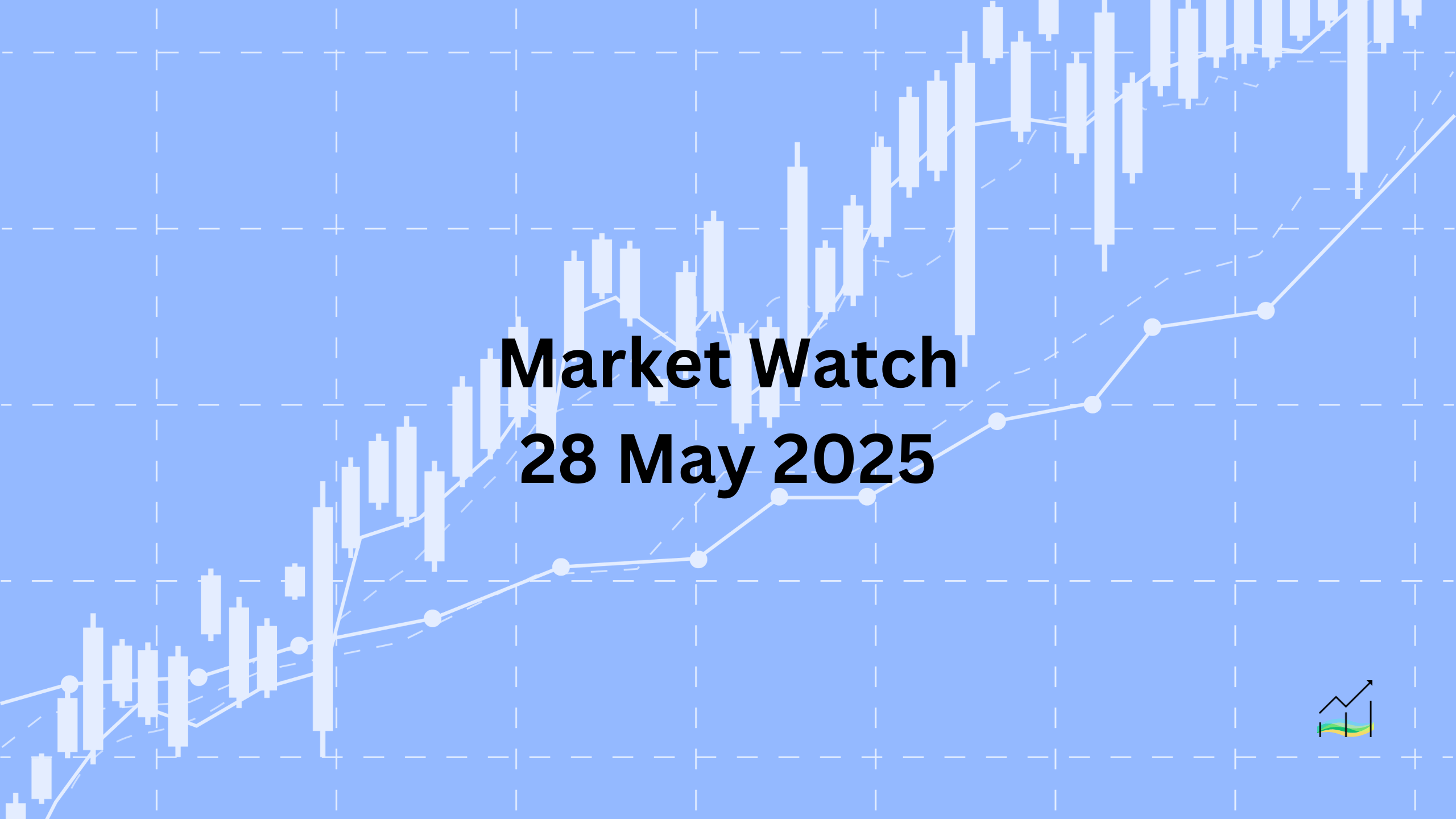28/05/2025 Market Watch

Markets Mixed as Dollar Softens & Yields Rise
Key Takeaways:
- The US dollar is weaker against most G10 currencies.
- The New Zealand dollar is leading gains despite a rate cut.
- Risk sentiment is mixed: equities are soft in Asia and Europe, while US futures are lower.
- Bond yields are rising globally, led by a weak Japanese bond auction.
- Gold is rebounding after recent losses, while oil remains rangebound.
The US dollar is broadly under pressure to start the week, weakening against nearly all G10 currencies. Surprisingly, the New Zealand dollar is showing the strongest performance, even after the central bank delivered a widely anticipated 25-basis point rate cut. In contrast, the Canadian dollar is trailing behind and remains the only G10 currency struggling to gain ground against the greenback. Emerging market currencies are also trading with a firmer tone, suggesting a general risk-on tilt in the FX space.
Equity markets are delivering mixed signals. Despite a strong session on Wall Street yesterday, most Asia Pacific stock indices have declined, with Taiwan being the exception. In Europe, the Stoxx 600 has surrendered much of yesterday's gains, and US index futures are trading slightly lower, hinting at a tentative start to the North American session.
Bond markets are under clear pressure. Japan’s 40-year bond auction saw its weakest demand in nearly a year, pushing yields higher across the Japanese curve. In Europe, 10-year yields are generally 2 to 4 basis points higher, though Italian bonds are outperforming and remain steady. US Treasuries are also weaker, with the 10-year yield climbing to around 4.47%. Investors are eyeing upcoming US auctions, including $28 billion in two-year floating rate notes and $70 billion in five-year notes.
In commodities, gold is attempting to recover after a sharp 1.3% drop yesterday. It is up around 0.75%, trading near $2,324 in late European hours. Oil markets are quiet, with July WTI holding within a narrow intraday range that remains inside yesterday’s broader trading band.
United States of America
Overview
The US dollar regained strength after an initial dip during North American trading, with the Dollar Index (DXY) bouncing from around 99.20 to near 99.60 following stronger-than-expected consumer confidence data. During Asia Pacific hours today, it briefly reached above 99.85 but failed to surpass last Friday’s peak just below 100.00. A decisive move above the 100.00–100.10 region could mark a shift in market sentiment toward a more sustained bullish outlook on the dollar.
While softer economic data had previously raised expectations of rate cuts, upcoming releases such as the Richmond and Dallas Fed surveys are unlikely to shift market expectations significantly. Fed officials remain cautious, emphasizing that a few weak data points are not enough to justify immediate easing. This is expected to be echoed in the FOMC minutes, which will likely confirm the Fed's reluctance to rush into rate cuts despite markets pricing in two cuts this year. Meanwhile, the ongoing decline in the oil and gas rig count – now at its lowest level since November 2021 – points to reduced energy sector activity, which could feed into future economic indicators.
Economic Drivers
- The rebound in US consumer confidence provided near-term support for the dollar.
- Fed policymakers remain cautious, signaling no urgency to cut rates based on recent soft data.
- Markets remain divided on the likelihood of two rate cuts in 2025, reflecting uncertainty in forward guidance.
- The falling oil and gas rig count highlights a slowdown in energy sector activity, potentially affecting broader economic momentum.
Data and Events
- 28 May 2025: FOMC Members Speak.
Price Action
- The Dollar Index found firm support near 99.20 and rebounded toward 99.85.
- A move above 100.00–100.10 would reinforce bullish sentiment on the dollar.
- Failure to surpass Friday’s highs suggests the market remains cautious pending further data.
Key Points:
- Dollar supported by consumer confidence rebound.
- Fed remains in wait-and-see mode despite soft data.
- Market cautious on the path to rate cuts in 2025.
- Rig count at lowest since late 2021 hints at slowing energy sector activity.
- DXY testing key resistance near 100.00.
Australia & New Zealand
Overview
The Australian dollar briefly reached a six-month high above $0.6535 earlier this week but has since retreated, finding support near $0.6425 before recovering slightly to $0.6450 in early European trade. The market's reaction was influenced by the April inflation report, which showed no change in the headline CPI at 2.4%. The trimmed mean, a key measure of core inflation, also remained flat in the 2.7%–2.8% range for the fifth straight month. Although the data fell slightly short of expectations, it is unlikely to shift the Reserve Bank of Australia's stance significantly before it sees May inflation data ahead of its early July policy meeting.
Interest rate expectations have slightly adjusted, with the futures market now pricing in around a 60% chance of a rate cut in July, down from 70% previously. Markets are currently pricing in close to 70 basis points of cuts for the remainder of the year. Among G10 central banks, the RBA remains the most dovish in outlook, contributing to broader market expectations of a looser policy path.
Across the Tasman, the Reserve Bank of New Zealand delivered a widely anticipated 25-basis point cut, lowering its official cash rate to 3.25%. This marks the fourth rate cut this year, totaling 100 basis points, on top of 125 basis points in easing last year. The swaps market reflects expectations of at least one more cut this year, with a slightly greater than 25% probability of a second cut as economic conditions remain fragile.
Economic Drivers
- Australia’s headline inflation held steady at 2.4% in April, with core inflation unchanged in the 2.7%–2.8% range.
- The RBA remains cautious but is perceived as the most dovish central bank among G10 economies.
- Market expectations for a July rate cut in Australia have moderated slightly, reflecting uncertainty around inflation momentum.
- New Zealand’s central bank continues its easing cycle, cutting rates by a total of 100 basis points this year.
- Sluggish domestic demand and a soft inflation outlook are shaping monetary policy expectations in both countries.
Data and Events
- 28 May 2025: AUD CPI.
- 28 May 2025: NZD Official Cash Rate.
- 28 May 2025: RBNZ Monetary Policy & Rate Statement.
- 28 May 2025: RBNZ Press Conference.
Price Action
- AUD/USD peaked above $0.6535 before falling to a low near $0.6435.
- Found support around $0.6425 and rebounded to $0.6450 in early European trading.
- NZD broadly firmed following the rate cut, as the move was fully priced in.
Key Points:
- Australian inflation data unchanged; market repricing July rate cut probabilities.
- RBA seen as the most dovish among G10 central banks.
- RBNZ delivers expected rate cut; easing path remains in focus.
- AUD and NZD reacting to interest rate expectations and inflation outlooks.
China
Overview
The offshore yuan has recovered significantly since the dollar reached record highs near CNH7.43 in early April. By Monday, the yuan had strengthened nearly 3.6%, with the exchange rate dropping to around CNH7.1615. However, the recovery paused as the dollar rebounded slightly to approach resistance levels near CNH7.2015, before pulling back again to session lows around CNH7.1860 during early European trade. The price movement suggests ongoing volatility as markets assess both domestic policy shifts and global macro conditions.
The People's Bank of China (PBOC) has maintained a firm grip on daily reference rates, setting the yuan fix below CNY7.19 for the third session in a row. Today’s fix was set at CNY7.1894, modestly higher than the previous two sessions. This approach suggests the central bank is attempting to manage depreciation pressure without allowing excessive volatility in the currency markets.
On the policy front, two key reports have captured attention. First, Beijing’s upcoming five-year plan—expected to be formally introduced in March—may intensify efforts toward economic self-reliance and import substitution. This shift reflects growing strategic emphasis on domestic production and reducing reliance on foreign technology. Second, the PBOC is reportedly encouraging major financial institutions to increase the share of yuan-denominated lending in cross-border transactions from 25% to 40%, supporting the broader push to internationalise the renminbi.
Economic Drivers
- The yuan has recovered 3.6% from April lows against the dollar.
- The PBOC is managing currency expectations by keeping the daily reference rate below CNY7.19.
- China’s upcoming five-year plan may prioritise economic independence and import substitution.
- The central bank is urging banks to increase yuan lending in international trade to promote currency internationalisation.
Data and Events
- 28 May 2025: CB Leading Index.
Price Action
- The dollar peaked near CNH7.43 in April and fell to a low near CNH7.1615 on Monday.
- Resistance was tested around CNH7.2015 before the dollar reversed toward CNH7.1860.
- Short-term price action suggests volatility around central bank fix levels and macro headlines.
Key Points:
- Offshore yuan has recovered from April’s highs, supported by central bank guidance.
- PBOC is actively controlling the reference rate to stabilise market expectations.
- China is pivoting toward greater economic self-reliance and yuan internationalisation.
- CNH trading remains sensitive to both policy signals and technical resistance levels.
Europe
Overview
The euro has faced renewed selling pressure after an unsuccessful attempt to regain ground early in the North American session. It briefly touched resistance near $1.1380 before sliding to session lows around $1.1320 as European markets closed. The weakness extended into today, with a temporary dip below $1.1300—an area of concentrated option interest worth 1.4 billion euros. Despite this, the euro found support near the $1.1275–1.1285 region and rebounded modestly to around $1.1340 during the European morning. Another sizable option expiry at $1.1400, amounting to roughly 1.3 billion euros, also falls due today, contributing to intraday volatility.
The broader narrative in the eurozone remains focused on the weakening inflation trend, with market attention squarely on actual CPI figures rather than long-term expectations. The ECB’s latest inflation forecast survey showed minimal change, with the three-year projection steady at 2.5% and the one-year view rising slightly to 3.1% from 2.9%. However, the spotlight is firmly on realised inflation. France reported a drop in its harmonised annual CPI to 0.6% from 0.9%, and expectations are for further declines in Germany, Spain, and Italy. The aggregate eurozone CPI is due next Tuesday and will likely shape market positioning ahead of the June 5 European Central Bank meeting, where a rate cut is now almost fully priced in. A second cut in early Q4 is also being factored into the forward curve.
Economic Drivers
- France’s harmonised CPI fell to 0.6% year-over-year, confirming a broader disinflationary trend.
- ECB inflation expectations remain mostly unchanged in the medium term, with a slight uptick in the short-term forecast.
- Markets are heavily focused on actual CPI data from key member states, which are expected to show continued softening.
- The swaps market is nearly fully pricing in a rate cut at the June ECB meeting, with a second move expected in Q4.
Data and Events
No major economic releases are scheduled today.
Price Action
- Euro failed to hold gains above $1.1380 and fell to $1.1320 before breaking below $1.1300.
- Strong support emerged around $1.1275–1.1285, helping to lift the euro back toward $1.1340.
- Option expiries at $1.1300 and $1.1400 are influencing short-term price dynamics.
Key Points:
- Euro weighed down by soft CPI data and expectations of ECB easing.
- Disinflation trend continues across major eurozone economies.
- Rate cut at the June ECB meeting is nearly fully priced in.
- Large option expiries adding to short-term volatility in euro trading.
Japan
Overview
The Japanese yen weakened sharply as the dollar surged toward JPY144.50, marking its strongest session in two weeks. This rally occurred despite a notable drop in US 10-year Treasury yields, highlighting the current disconnect between US-Japan rate differentials and actual currency moves. The dollar briefly pushed into the JPY144.60–144.80 resistance zone, which includes the 38.2% retracement of its recent decline and the 20-day moving average, but failed to break higher and retreated to stabilize around JPY144.00 during the European morning.
Domestically, uncertainty looms over policy direction. The Ministry of Finance recently sent a broad survey to market participants seeking views on market conditions and issuance plans. Meanwhile, Japan’s 40-year bond auction was met with weak demand—the softest since July last year—indicating potential investor caution amidst rising yields. April’s consumer price index came in hot at 3.6%, while long-end bond yields remain elevated, with the 30-year yield still above 2.90% and the 40-year yield near 3.35%.
On the political front, attention is shifting to domestic agricultural pricing. Japan’s new farm minister, Koizumi, has aggressively intervened in the rice market, ordering the release of 300,000 metric tons from government reserves after prices nearly doubled last month. His success in stabilizing prices could elevate his political standing, potentially setting him up as a challenger to Prime Minister Ishida later this year. Separately, the government announced it will allocate JPY900 billion from reserve funds to cushion the impact of US tariffs, a move that reinforces its commitment to short-term economic stability.
Economic Drivers
- The Ministry of Finance is gauging market sentiment through new surveys on conditions and issuance plans.
- April CPI rose 3.6%, indicating persistent inflationary pressures.
- Long-term bond yields remain elevated amid weak demand, especially for the 40-year auction.
- The government plans to release 300,000 metric tons of rice from stockpiles to manage food inflation.
- Political uncertainty may increase if Minister Koizumi succeeds in lowering rice prices and challenges leadership.
- JPY900 billion in reserve funds will be used to offset the economic impact of US tariffs.
Data and Events
No major economic releases are scheduled today.
Price Action
- USD/JPY surged to JPY144.50 despite falling US yields.
- Encountered resistance near JPY144.60–144.80 and pulled back to JPY144.00.
- Market remains sensitive to long-end yield movements and intervention risks.
Key Points:
- Dollar rally shows growing decoupling from yield dynamics.
- Inflation and rising bond yields signal persistent macro pressures.
- Political risks are rising ahead of key elections and leadership positioning.
- Government steps in to manage food and trade-related economic risks.
© 2025 SKONE Enterprise (003319453-V). All rights reserved.
The content on this site is for informational purposes only and does not constitute financial advice.


